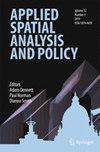What Characteristics of Urban Parks are Associated with High and Stable Visitor Flow? A Spatiotemporal Exploration Using Mobile Phone Data
Abstract
The prevalence of urban parks serves as a crucial indicator for assessing a city’s vitality and livability. However, limited research has revealed the key characteristics of parks that attract large and stable numbers of visitors. In this study, we established intensity and stability indicators to trace fine-granular flow of visitors in parks. Visitor flows was analyzed using mobile phone signaling data with an accuracy of hourly data, which also represented the spatiotemporal patterns of park visitation. We delineated the patterns of 96 parks in Jinan, a prominent city in North China. Patterns of visitation exhibit diverse features of peak gatherings. The intensity and stability of park visitation are both subject to typical weekday-weekend variations, as measured by the accumulated visitor flow and the Shannon entropy. The effects of environmental factors on park visits were examined by using regression models. Factors that significantly influence the intensity and stability of park visits are the surrounding transportation facilities and the distance from the city center. The factors of surrounding population density and allocated construction land exert additional influences on various temporal periods. Understanding the spatiotemporal patterns of park visitations provides insights into advanced strategies for optimizing park resources and refining park management.


 求助内容:
求助内容: 应助结果提醒方式:
应助结果提醒方式:


